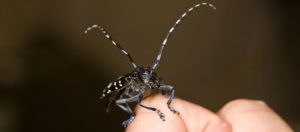Iowans warned to be on guard for invasive, tree killing beetle
August 18th, 2022 by Ric Hanson
(Radio Iowa) – Iowans are familiar with the emerald ash borer and the green insect’s threat to our foliage, but we’re also being asked to be on guard for another insect that’s equally as lethal to a much wider variety of trees. Rhonda Santos, a spokeswoman for the U-S-D-A, says Iowa homeowners should examine their trees for the Asian longhorned beetle and report any clues they find about the invasive pest.
“Now is the best time to look for and report the signs of the Asian longhorned beetle in your backyard and in your neighborhood,” Santos says. “This wood-boring beetle attacks many types of trees and is a threat to our shade trees, recreational areas and our forest resources.” Unlike the emerald ash borer, the Asian longhorned beetle likes to feed on a host of trees, including: ash, birch, elm, sycamore, maple, buckeye, poplar and willow. The bug has distinct markings and leaves behind a series of holes and other signs in trees that make it quick to identify.
“The beetle is easy to recognize with their black and white antennae, shiny black body with white spots, and six legs,” Santos says. “The beetles create round holes and scars in the tree bark, sawdust-like material around the tree, and can cause branches to fall.” The beetle is not native to the U.S. and has few-to-no natural predators. Santos encourages Iowans to take five minutes and give your trees a close inspection for those round holes or sawdust.
Santos says, “If you see these signs, take photos and capture the suspicious insects to help the USDA with identification.” The beetle was first spotted in the U.S. in New York in 1996 and spread quickly. It’s one of a group of invasive pests and plant diseases that costs the nation some 40-billion dollars each year in losses to trees, plants, and crops. For more information or to report the insect or tree damage, visit www.asianlonghornedbeetle.com.






